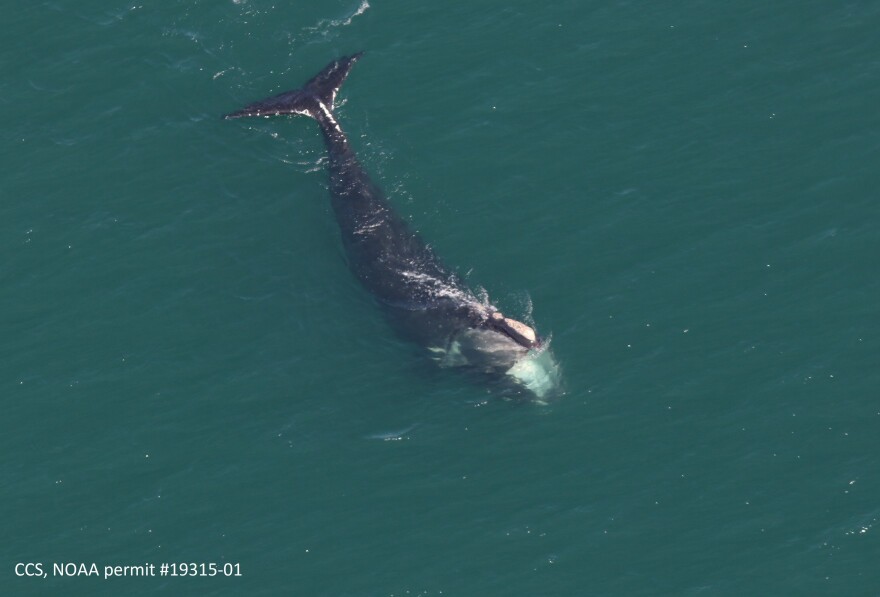On a recent cool, windy day, a team of scientists aboard a weathered 55-foot sailboat motored across Cape Cod Bay toward Provincetown, where dozens of North Atlantic right whales had been spotted days earlier.
“A bunch of whales were seen on a line between the mouth of Barnstable Harbor to Wood End off Provincetown. So we’re going to head that way,” said team leader Michael Moore, a veterinarian and scientist with the Woods Hole Oceanographic Institution (WHOI).
The goal of Moore’s years-long research is to evaluate whether North Atlantic right whales are growing in healthy ways. The whales are nearing the end of a three-month period during which nearly half the population of approximately 360 can be spotted in Cape Cod Bay.
It’s a unique opportunity for researchers to take stock of the critically endangered species.
“Today I’m hoping to find some whales and get some drone photographs of them to measure them, figure out how fat and long they are, and see how that compares to the last time we saw them,” he said.
To Moore, it’s a mistake to gauge the health of this species based on population numbers alone. More than 80 percent of the survivors bear scars of entanglement in rope and fishing gear, but little is known about how the trauma impacts their ability to repopulate.
“All the news and the noise right now is, ‘Whose rope killed this whale?’” Moore said. “It's not just about killing whales. It's also about the health of the animals that are still alive and their ability to get pregnant or not. And that's a much more subtle, more nuanced question.”
The least-invasive way to measure a right whale, he added, is to use a drone rigged with a specialized camera that can hover over the whales. It can also help researchers know which particular whale they’re looking at.
“Right whales are beautifully equipped for drone work in terms of identification,” he said. “They wear their identity on their heads in the form of callosities,” which are massive calluses that are unique to each individual whale. “So every time we take a photograph, we know who it is.”
Researchers maintain a catalog of these whale images to keep track of who's who: which whales are alive, where are they moving, and whether they have new scars.
But on this day, after five hours on the water, more than 30 miles travelled, and a redirection back toward waters just north of Plymouth, Moore’s team had still not seen a single whale.
Then, Amy Knowlton, a senior scientist with the New England Aquarium, caught sight of a fluke, emerging triumphantly out of the water.
“Oh, there it is!” she called out.
But the massive whale was 300 meters away and diving for five to 12 minutes at a time. It took another two and a half hours – and many tense moments of searching – before the team could get close enough and the whale stopped diving. Finally, they got so close, they could hear the whoosh of misty air and vapor puffing out of its blowhole.
“His mouth was open there,” Knowlton said, as the shutter of her camera whirred.
Recognizing the limited window for data collection, Michael Moore readied himself on the deck with the drone. The sky was beginning to darken, and he knew he would have just this final chance to capture the essential data.
He and fellow WHOI scientist Carolyn Miller stood at the bow. Wearing a white helmet, she held the foot-long drone above her head and Moore launched it out of her hands, 200 feet into the pale blue sky. She sat down, watching an iPad and directing Moore as he piloted the drone.
“Forward, and right, and right,” she called. “Forward, forward, forward, forward, right, right, right, right.”
The two were in sync as the drone camera flew directly above the whale.
“These are great shots,” Miller said.
On the screen, the shiny, blue-black whale, with its mouth open, fed on a reddish plankton called copepods. At one point, it turned on its side, revealing its belly, as it began to change directions.
As the sun began to set, the team got the shot that would allow for clear measurements and a solid ID for the whale: a 13-year-old juvenile male familiar to researchers.
His name is Garlic, and he’s known to have been entangled at least three times: in 2009, 2015, and again in 2018. All have left indelible scars.
“Let's go home. Thanks, guys,” Moore said to the crew, “We got some data!”
“You got it,” Knowlton said.
“Thank goodness,” Miller echoed.
“After all that,” Moore laughed, “we got some data.”
By day’s end, tired but satisfied, the researchers had spent 11 hours on the water. Armed with fresh information about Garlic – a whale that represents the potential future of the dwindling species, and also the threats it faces – they planned to get some rest and return to the bay the next morning.




